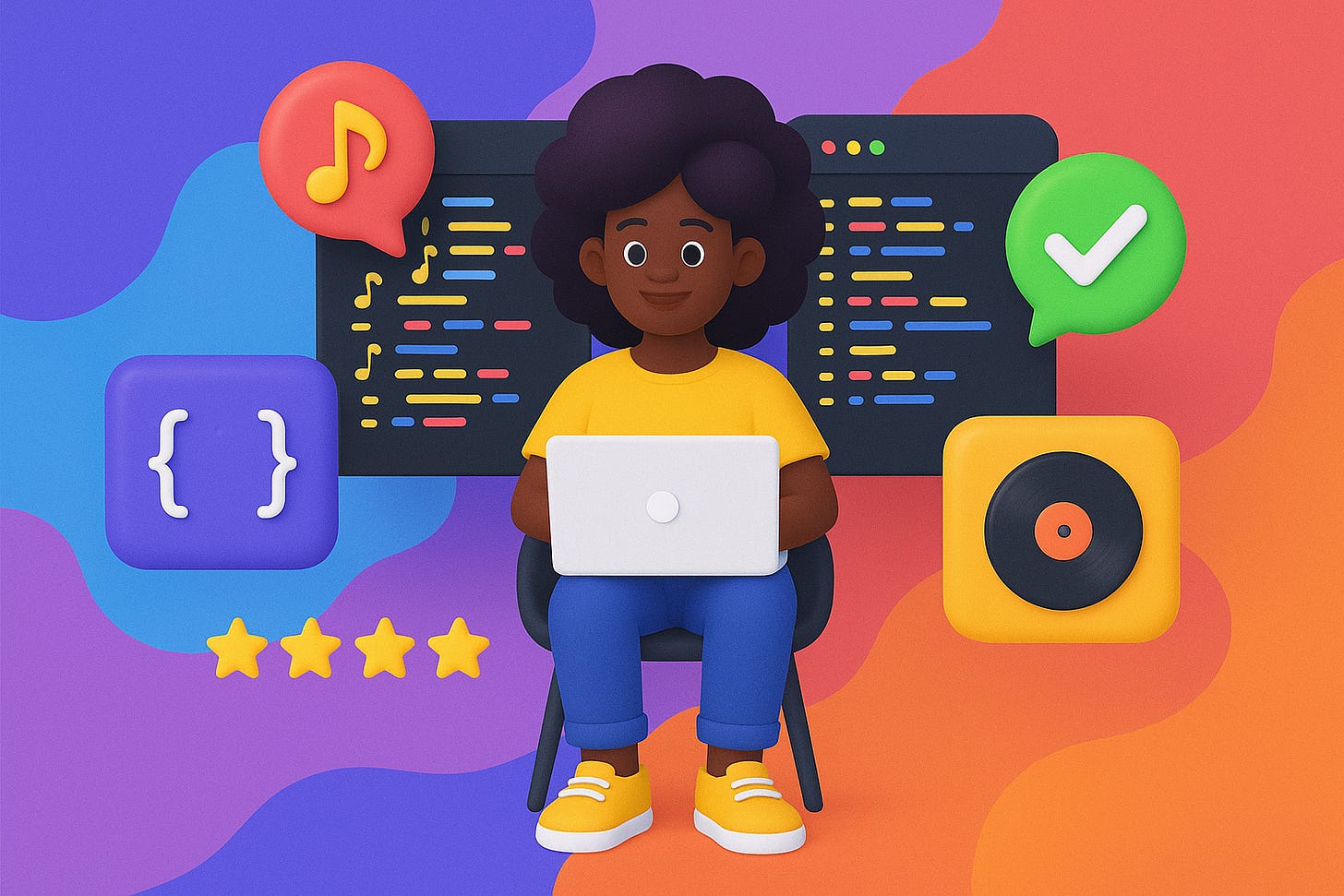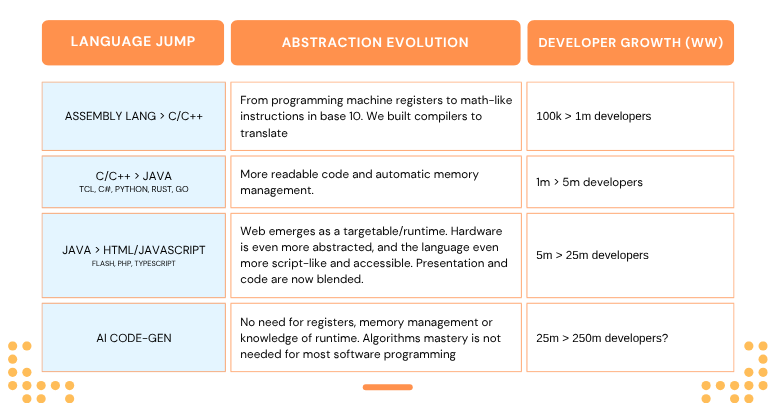Vibe Coding Isn’t a Paradigm Shift. It’s the Next Step.
But we all need to step back from the hype a bit
Want to listen to us talk this one out in real-time instead? Here’s a link to our podcast session on vibe coding and vibe product management.“You know, the funny thing is… we’re about to go from 25 million coders to 250 million coders—but 150 million of them will be vibe coders.” That off‑hand remark sums up the promise and the peril of AI‑driven, “vibe-coding”. It sounds like a revolution, but in reality, it’s just another aggressive step in the march of human-driven computer programming— but one that will crack open 40 years of development practice.
Defining “Vibe Coding” Isn’t Easy—And That’s the Point
What exactly is vibe coding? We see 2 flavors - low and high expertise versions. The low-expertise definition usually goes along the lines of: a person who cares about a problem can “vibe” out a software solution using AI design and coding tools, without diving into tech details or caring about assembly. The “vibe” part means the system seems to anticipate your needs—it fills in the gaps so you don’t have to. That imprecision is seductive: “Hey, I’m feeling this interface, let’s see if I can translate my vibe for it into reality.” There is a high expertise version of vibe coding, though that’s been evolving for 2 years - where existing developers augment their expertise with tools like Windsurf (which was just acquired by OpenAI for $3b) to become even more capable.
In both cases, we’re seeing generative AI drive the abstraction of complexity to its logical point - any human language + logic + architecture = software development. That language can be Igbo, Swahili, Icelandic, or English; all can be translated into a computer language by an AI agent. The need to master an actual ‘coding language’ will almost vanish in the coming years. But along with it, will also diminish the ability to peek under the hood and master important details about how computers work… like software security or performance tuning.
From Assembly to JavaScript to… Vibe Coding
Every major leap in computing has expanded the developer pool by higher-level abstraction (aka hiding details, which we like because we don’t naturally think in binary):
Each step added millions of new coders. Vibe coding is just the next rung: translating plain English (or any native language) into code while masking all the complexity of machine language in totality. But anyone remember the Java boom? It created legions of “Java jockeys” who could crank out mediocre enterprise apps. Every code simplicity jump came with many low skilled entrants who banked on simplicity and instead delivered lower quality —exactly what we are seeing today with AI‑generated code. It’s not a new paradigm; it’s history repeating itself and its always worth learning the lessons of history.
Vibe Coding serves a business need because of bottlenecks, but …..
We know coders are among the priciest professionals in technology businesses. And business leaders regularly complain that “their” tech team is building the wrong thing. What they really mean is: “How hard can this be?!” or “Deal with what I think it important first”. So on the plus side, vibe coding tools relieves pressure by letting savvy business users (the front line of customer pain), hack out small solutions, quick fixes and workarounds, bypassing the backlog. This awesome at that scale, but when it comes to production‑grade systems, there is danger of collapse under performance, security, and scale requirements.
Micorosoft built Visual Studio LightSwitch for business coders. But it required way too much developer skill and was a tool before its time for ordinary business workers with problems to solve for their workflows.Does anyone remember the data dashboard craze? Vendors promised that non‑technical users could slice and dice data without code using their new tools. But only the power users succeeded; everyone else ended up hiring data scientists to build real analytics pipelines they could actually rely on.
Or what about Visual Basic which was supposed to make building apps easy. Countless VB users churned out business apps that looked impressive but ran terribly.
The Limits of Vibe Coding
If we abstract out the need to learn a formal language to make valuable software - the oil of the technological age we are in the process of building - what remains?
Here are a few thoughts on what to expect in this new era:
Starting will be easy
Ordinary people will be able to get started on ‘automating’ a problem they have. What engineers used to call ‘scripts’, will become so accessible that your toddler will code (eventually). At ProductMind, we’re writing a lot of toddler and prototype code. For ourselves first and then as specifications for more ambitious projects we are working on, a faster way to collaborate with experienced engineers. Its never been easier to get your ideas into code quickly and tweak it to work. However this favors low complexity software.
Finishing will be hard
To make something commercial and complex usually takes more time. To finish and polish initially crappy and uncompilable AI generated code often requires spending more than a few minutes in an actual code tool to debug problems. And then the unseen parts of release creeps in - getting this to an app store or in a state to share, building marketing ptches and value propositions, and accepting payment - all part of the art of getting it beyond your desktop or phone into someone else’s. Even good tools built for yourself will need a certain level of finish for you to rely on them daily. Think of all the tools you use daily, and then consider how the refinement interacts with your reliance on them.
Exactly.
Complexity often defeats low-expertise vibe coding
Beyond mere finishing of a piece of software is dealing with complexity. To build something commercial or groundbreaking often requires complicated code, that is needed to defeat entropy and cater to the variation in how humans handle software. For example, let’s consider: what kind of software does it take to make a common web search query return in 0.001 seconds from anywhere in the world? Or for a Zoom call to connect people 3000 miles apart? To monitor a nuclear power station? These are hard problems that require clever, careful and complicated engineering.
It turns out that building a garden shed is vastly different from building the Empire State Building. Even powerful vibe coding tools often help dilletantes build garden sheds. Many technoloty businesses are essentially building an empire state building every year. Think Microsoft Office, Adobe Photoshop, ChatGPT. In the long run, all these kind of scalable software will be started quickly by some flavor of vibe coding (good thing!), but to conclude them and turn them into real technology companies that make money, you will need clever and qualified engineering to build them. This means trained computer scientists will be needed to architect carefully. Things that truly creative and scale will still require more than a modicum of non-vibes driven engineering and architecture.
Security and liability will still require an experienced and professional coder class
One of the most perplexing aspects of the democratization of code is the lack of understanding of some of the hidden business aspects of technology services. One key one is the duty developers have to their customers around privacy and security. Apocryphally, a recent ‘successful’ vibe coder asked the public to check out his new vibe-coded platform. As part of checking it out, it was trivially hacked in seconds using a SQL injection attack. Every iteration he put out was hacked in seconds by professionals. The issue was not the insecure nature of what he made (which was very clever), but that he did not have the knowledge to secure it. He did not know the fundamentals of security, so vague prompts to a model to secure the code were largely unsuccessful. The lesson? AI cribbing from public data can introduce known vulnerabilities at warp speed.
Eventually, code-gen models will easily output more secure code, but it’s worth noting that security is non-trivial even for professional developers. There is a reason the industry still put out security bug bounties in the millions of dollars. It’s an acknowledgement that even the best miss important things. And if they do, by definition, the model will also continue to miss important things - they’re based on our creative knowledge.
Recent laws make it so that businesses that employ technology are liable for privacy and security issues. A single vibe coder that creates a successful software platform is that ‘business’ and will need to backstop the reliability, privacy, and security protections. Not knowing what they are is not a defense.
In conclusion on this graf on the limits of vibe coding, most non-software engineers don’t appreciate how hard it is to make software that works every single time and how much hard work it is to make it so, even while adding new capabilities and features to further satisfy your customers. The perception is that sky-high developer salaries are somehow not rational. Nothing could be further from the truth. It’s the same logic for why professionals who work in petroleum energy get paid a lot of money. It’s hard, dangerous, and exacting work, when done right. Serious business will still require serious talent if maybe not so much of it given new augmented super powers on offer from vibe-coding tools.
Beyond the Hype: Building the Right Thing
What AI code-gen models have done is lower the barrier to entry to building software - from mastering a coding language to just mastering your native tongue + some architectural acumen and logic. That last part is the key to professionalism and profits. Real and sustainable innovation will still live in the hands of experienced builders who accumulate that acumen and logic. They will balance high‑pressure trade‑offs, optimize for scale, and fuse business judgment with technical constraints. AI can generate permutations, but only humans can weigh the critical 5% of use cases that define a product’s success. That doesn’t negate the utility of these tools—it simply underscores that expertise remains the ultimate differentiator.
Critically, remember that at the end of the day, code is just a means to an end. AI may help you build features faster, but it won’t solve the eternal product question: are we building the right thing? Vibe coding amplifies thrust—more lines of code, more features—but unless you upgrade your navigation and steering systems, you’ll rocket off course quicker than ever.
We are looking with interest at the newest “Vibe Product Management” tools that are coming out as we believe a paradigm shift analogous to the agile manifesto is needed in the age of AI. Stay tuned.
Here’s that link again to our podcast session on vibe coding and vibe product management.







